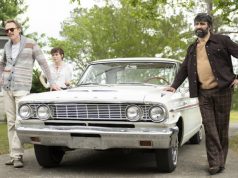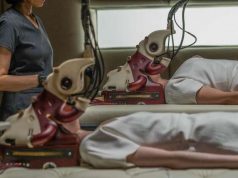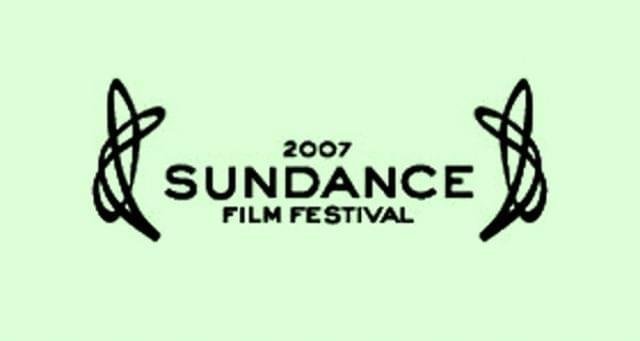
Day 1 (Thursday, Jan. 18):
Do not be alarmed! The powerful smell coming from the mountains of Park City, Utah, is not biochemical or toxic in nature. It is merely the vigorous scent of independent film! (Yes, it smells like profanity and lesbians.)
The 2007 Sundance Film Festival began tonight and kicks off for realsies tomorrow. The opening night screening was a docudrama called “Chicago 10,” which is not the ninth sequel to the Oscar-winning musical “Chicago”; in fact, that’s not even a very good joke to make. It’s the story of the protesters who were arrested at the 1968 Democratic Convention, and the courtroom circus that ensued. Surely the events of that tumultuous period in American history remain fresh in our memories, even though we were not born until 1974.
I maintained my policy of not going to the opening night screening — too hectic, too many long lines — and instead met with my fellow Salt Lake City Weekly correspondents at the cozy digs reserved for us near The Canyons ski resort. It had been a wearying day of travel, and we all wanted to get to bed early. (Not with each other. It’s not THAT kind of place.)
Day 2 (Friday, Jan. 19):
I arose at 7 o’clock this morning. Seven a.m.! Maybe you’re not as impressed by that as I am, but trust me, 7 a.m. is a praiseworthy feat. But such superhuman measures — do I brag to call myself superhuman? I leave that for history to decide — were necessary today, for word on the street was that there might be some delay in getting my press credentials, and I didn’t want to miss any screenings because of it.
You see, press passes are supposed to have photos on them, presumably to prevent people from lending them out, unless they lend them to someone who looks just like them; I guess you could probably get away with that. But somehow, the good folks at Sundance lost a bunch of pictures, and so when some members of the press were showing up to collect their passes, they were instead being ushered into a long line to have their photos re-taken so that new credentials could be issued. It was apparently quite a grumbly debacle yesterday, when early-bird journalists thought they were getting ahead of the game by arriving on Thursday, only to be delayed.
Simply issuing the passes without photos, and maybe requiring people to show photo ID when using them, would of course be pure folly.
Having been tipped off that my photo was among the lost ones, I got to the press office as soon as it opened today, at 7:50 a.m., hoping to be first in line. I managed second place, behind an Australian freelance journalist who is notorious for being prickly and diva-esque, and who was in fine form when he discovered his press pass was not ready for him. When the tirelessly good-natured Sundance press coordinator Patrick Hubley walked past to say good morning, this fellow greeted him with a bellowing, “There are problems already!” Patrick ushered him straightaway to the photo booth, treating him with far more courtesy than the jerkwad deserved.
The staff member in charge of taking the photos and printing out new credentials, Amberly, couldn’t have been nicer. Considering how many grumpy journalists she had to deal with yesterday, and considering Aussie McPrimadonna was her first customer this morning, I was amazed by her friendliness. Turns out my photo was still in the system after all, and I was soon on my way.
Up first was a 9 a.m. press screening of “Once,” a lovely Irish film about a street musician who befriends a pianist, whereupon the two make beautiful music together. The film is a musical of sorts (lots of singing, though not of the walking-down-the-street-and-we-burst-into-song variety), and I particularly liked that when characters in the film raved about how good the duo’s songs were, the songs had actually been good. I hate when movies or TV shows feature entertainers performing material that’s supposed to be great but isn’t. (“Studio 60,” I’m looking at you.) (For about two more episodes, that is, and then I quit you.)
The screening was marred only by the reappearance of the latest festival plague: the BlackBerry-using a-hole who doesn’t care that his BlackBerry lights up the entire theater when he uses it during the movie. I feel bad for these people, first for being so boorish that surely no one will ever love them, and second for having to suffer through the constant intrusion of movies upon their very important BlackBerrying. If the projectionist would just turn up the lights and turn off the film, they’d be able to play with their BlackBerrys in peace.
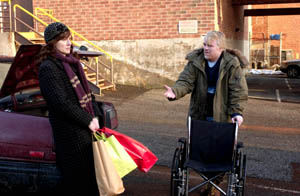
There wasn’t much time to kill after “Once” before my next press screening, “The Savages.” This proved to be a solid, mature film about two adult siblings (Laura Linney and Philip Seymour Hoffman) dealing with their aging father as he becomes unable to care for himself. It’s sharply funny at times — Linney and Hoffman are both great at that — and sadly poignant other times. Good stuff.
Two movies, two thumbs up, right out of the gate! The festival was off to a good start, movie-wise. Insufferable a-hole-wise (Australian and non-), not so much.
My eFilmCritic pals Scott Weinberg and Erik Childress were at “The Savages” with me, and we three, accompanied by Cinematical‘s Kim Voynar, went in search of lunch immediately thereafter. It is curious that while the entire Western United States, Utah included, is growing by leaps and bounds, populations expanding rapidly with each passing year, Park City remains unchanged. Burger King is still the only fast food place near the festival hub; the semi-grody Chinese buffet is still right there in the same shopping center; the only real change is that the burrito place next to it is now a pizza place. We opted for the Chinese buffet, and it was $8.13 (with tax) well-spent, I guess. Unlike the movies, I have no firm opinions on the Chinese buffet.
With a few hours before my next screening, I headed up to Main Street to see what was shakin’. The sun was warm, the sky was blue, the mountain air was fresh and invigorating. As I got off the shuttle bus at Main Street, comedian David Wain was attempting to get on. If you don’t know David Wain, you should rent the DVDs of the TV series “Stella” that he did with Michael Ian Black and Michael Showalter, and bask in the absurdity. Alas, there was not enough time for me to express geeky fondness for Mr. Wain before he and a lady friend were on the bus and whisked away.
I went to the Sundance House, which is normally the Kimball Art Center but which becomes a lounge for Sundance pass-holders during the fest. I intended to get some writing done, but I encountered a strange complication: There were no electrical outlets to plug my laptop into. There’s a lounge full of laptops that we can use, but those laptops occupy all the outlets in the room. If you brought your own laptop, and if that laptop should require plugging in, you are out of luck. Is it some sort of conspiracy to force people to leave their computers at home and use the Sundance-provided ones? Or am I the only journalist in attendance whose laptop needs to be charged regularly?
I ought to have asked someone in charge (har!) if maybe there was a power strip we could plug into one of the outlets to expand its usefulness, but I didn’t think of that until later. What I thought of at the moment was that, David Wain sighting aside, my trip to Main Street had been a waste of time. It didn’t help that the bus back to the Yarrow Hotel (where all the press screening action is) took one hundred years to get down the hill. ONE HUNDRED YEARS.
The next screening was “Weapons,” a “gritty” (read: violent) drama about teens having sex with and/or killing one another, rather reminiscent of the current theatrical release (and 2006 Sundance selection) “Alpha Dog.” There are a lot of things I liked about “Weapons,” but an equal number of things I hated. There were many walkouts during the press screening, which does not bode well. In the second half of the festival, the hardy journalists are more apt to lose patience with bad movies. But on the first day? Yikes. That’s gotta sting, if you’re the people who made “Weapons.”
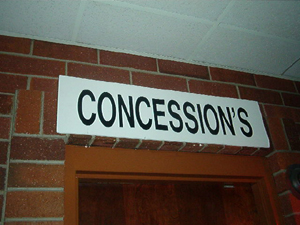
Weinberg and I hit Burger King next, having resigned ourselves to eating there every day for the next week, as we always do. Then it was back to the Yarrow, where I noticed the concessions stand had a large sign reading: “CONCESSION’S.” Attentive readers may recall that they had the same sign last year, and that I removed the offending apostrophe. Now the sign was back, the apostrophe reinstated — and the sign was hung high up on the wall, out of reach. Was this done to keep it from prying, correcting hands? It’s probably a coincidence, but I’ve found that life is more interesting when you smell conspiracy in everything.
Speaking of odd punctuation, my fourth and final film of the day was “It Is Fine! Everything Is Fine.,” with that period officially part of the title. (The film guide and other printed materials even yell the second part — “EVERYTHING IS FINE.” — but the actual on-screen title uses its indoor voice.)
This is the work of Crispin Glover, the actor/director/musician who played George McFly in “Back to the Future,” almost kicked David Letterman in the head in 1987, and directed the 2005 Sundance entry “What Is It?,” which is one of the most bizarre films I’ve ever watched. Glover is, if I may quote the Bible, as crazy as a craphouse rat.
And whom should I see strolling down the hallway outside the room where “It Is Fine!” was to be screened? Mr. Glover himself, sharply dressed as always, placid-looking, by all appearances quite normal and not at all the type of person who would make a movie about mentally challenged people killing snails and having sex.
It turns out he was there to introduce his film — something directors never do at press screenings. He mentioned he’d be back afterward for a Q&A, which is also normally reserved for public screenings. I say it’s bad form to show up at the press screening of your own movie. It makes the critics nervous, even when you’re not insane. Thank goodness he didn’t actually sit there at watch it with us. Maybe he finds it unbearable to watch, too, just as I did.
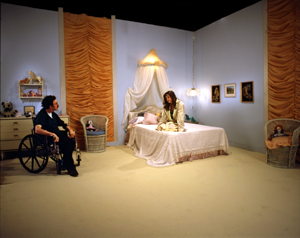
The central character is a man with severe cerebral palsy, played by a man with severe cerebral palsy. Ninety-eight percent of the things he says are unintelligible. Kudos for including handicapped people in a movie, but a film in which the audience can’t understand what the protagonist is saying is awkward at best, boring at worst. And the explicit sexuality and universally laughable acting certainly didn’t help matters. It was like watching porn as produced by the Special Olympics.
I did not stay for the Q&A. The only Q’s I was interested in seeing A’ed were:
1. What’s the matter with you?
2. What were you thinking?
3. Seriously, what’s the matter with you?
And I didn’t think anyone would ask him those questions, for fear of being kicked in the head.
So we wound up batting .500 today: two good movies, two bad ones. But at least the bad ones were bad in interesting ways. Seems like the festival is off to a good start, BlackBerrys and errant apostrophes notwithstanding.
Day 3 (Saturday, January 20):
The plan was, I would get up at 7:15 this morning and make the 8:30 press screening of “Snow Angels,” the new film from David Gordon Green, whose “All the Pretty Girls” I loved, whose “Undertow” I liked, and whose “George Washington” is on my TiVo awaiting my perusal. That was the plan.
But apparently, I really needed sleep. Despite going to bed early — only midnight — last night, when my alarm went off at 7:15 this morning, I … did nothing, apparently. I did not hear it. I have no memory of it. City Weekly arts editor Scott Renshaw says he tried to wake me, knowing I wanted to see the 8:30 movie, but to no avail. I assume he stopped short of throwing me off the bed, or setting my hair on fire, but I suppose those are not really the duties of an arts editor. Those are the duties of my mother, which Renshaw is not.
At any rate, it was 8:25 when I did wake up — thank goodness for my bladder! — so “Snow Angels” was out of the question. Still, it could have been worse. I could have slept until noon. I’ve done it before, and I will do it again.
With nothing now until 11, I got to press headquarters at about 9:15 to do some work. The scarcity of electrical outlets there rivals that of the Sundance House, but I managed to find one behind a display table that I could access if I shimmied behind the table. Work was accomplished; complimentary bottled water was drunk; the passive voice was used.
At 11 a.m. was a press screening that proved to be a hot ticket. Now, this early in the festival, there’s no legitimate “buzz” around anything, because no one’s actually seen anything yet. There is only curiosity: People have read the description in the film guide, and it sounds interesting.
The description of “Teeth,” the 11 a.m. film, is that it’s a horror-comedy-parody about a teenage girl who discovers her vagina has sharp, fang-like teeth in it, ready to bite down like a Venus flytrap on any foreign object they encounter. Who wouldn’t want to see a movie like that?!
It turns out to be a funny, gross, multi-layered movie, structured like a horror film (we never see the “monster”), satirical like a spoof of B-movie creature features, and even a little thought-provoking. The subject of evolution is brought up. A development like this (assuming the woman could control whom she admitted and whom she “bit”) would effectively put a stop to rape, wouldn’t it? Or if it didn’t, at least the rapist would leave plenty of evidence at the scene. And by evidence, I mean his wiener.
By the way, the film isn’t shy about showing the wounds created by the heroine’s vengeful vagina (vengina?). Guys, this movie is harder to watch than the torture scene in “Casino Royale.” As Weinberg put it, “‘Teeth’ will do for vaginas what ‘Jaws’ did for the ocean.” We’re guessing Lions Gate will pick it up, cut out the best parts to get a better rating, totally screw up the marketing, and the film will never be heard from again. But that’s just a guess.
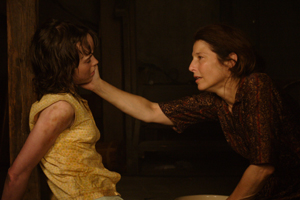
Next up was another must-see film, playing to another packed screening room (well, the same screening room, repacked). It was “An American Crime,” and I suspect much of the reason for the attention is that during last night’s public screening of it, someone passed out. Apparently the incident occurred just as something climactic or alarming was happening onscreen, which freaked out the audience even more. They stopped the film, turned up the lights, and got medical attention for the unlucky filmgoer.
I heard the account from a few different sources today, hearing “fainted” a couple times and “had a seizure” another time. I’d like to think it was the film’s alarming subject matter caused it — it’s the true story of an Indiana woman who locked up and abused a teenage girl in the 1960s — but let’s be honest here: There are a lot of reasons you might pass out at Sundance. Fatigue, sleep deprivation, drunkenness, the high altitude, and consumption of pharmaceuticals all spring to mind. Being shocked by a woman burning a girl with cigarettes would be a little farther down the list, especially considering there is also a movie about a girl with man-eating lady parts.
“An American Crime” is not, unfortunately, a very good movie. The subject matter is harrowing, but the film doesn’t know what to do with it other than simply recreate it the way court transcripts suggest it happened. It’s grim and horrifying for no good reason, like sleeping with Lindsay Lohan.
After the screening, I remembered a card I’d been handed earlier. The Yarrow, where most of the press screenings are held, is a frumpy (I’m sorry, “rustic”) hotel that has finally decided to make use of its Sundance connections by hosting cool, hip, with-it events during the fest. So I’d gotten this card advertising “Dreamland Village at Yarrow,” which is set up in an indoor courtyard and features some of the following:
“Rainforest Eco Tent.” (I don’t know.)
“Free Massage.”
“Free Internet Lounge.”
“Tsonga Shoe Gifting Lounge.” (I’m pretty sure “gifting lounge” means “store.”)
So my pal Childress and I wandered in to see what the deal was. The area has been made to look like a spa, with therapeutic crystals, and people lying on tables, and so forth. The sound of running water could be heard. What could not be heard was anyone coming over and saying, “Can I help you?” or “Were you interested in a free massage?” or “Welcome to the Dreamland Village” or anything. As far as I could tell, Childress and I were completely invisible to the dozen or so people milling around. So, I guess they succeeded in making the Yarrow hip, as I’m pretty sure I would be ignored like this if I walked into a trendy spa in L.A., too.
I had a couple hours before my next film, so I tried the pizza place that used to be a burrito place. I never went in there when it was a burrito place. I think it was one of those froofy burrito places — not a Mexican restaurant, but a restaurant where they’re like, “Oh, here’s some sun-dried tomatoes and chicken salad, wrapped up in an organic spinach tortilla!” and call it a burrito. That’s not a burrito; that’s a wrap. It’s totally different. Anyway, it’s a pizza place now, and they serve legitimate pizza — not that California Pizza Kitchen crap, where it’s like, “Oh, here’s a flat piece of bread, and we’ve put some pesto and cauliflower on it!” Californians ruin everything. And I say that as a Californian.
Anyway, properly fed, I went back to press headquarters to use that electrical outlet I’d found earlier. (If you’re wondering why my laptop must be charged so frequently, it’s because my laptop — which I use only when I travel; I have a good computer at home — was made in 1973 and is powered by coal.) Patrick Hubley, Sundance’s press coordinator and the world’s friendliest Canadian, stopped to ask me how things were going, and I mentioned the dearth of electrical outlets — I may have actually used the word “dearth” — and he said he would get his top people right on it. Of course, having seen the way he placated the Australian jerkwad yesterday, it’s entirely possible he was just humoring me, too.
Patrick asked if I’d checked out any of Sundance’s online stuff. I said, “No, I’ve been too busy watching movies on actual movie screens!” He said I should check out the online stuff and then write about it, so that people who read me would check it out too.
So apparently Sundance has some online stuff. Maybe some short films or something that you can watch. Oh, I do know you can watch some of the shorts on iTunes! So yeah, do that. That’ll be awesome.
Back to the press screenings next, with “Everything’s Cool,” a light documentary about global warming — or, specifically, about scientists’ efforts to overcome the misinformation campaign that has resulted in many people thinking global warming is a hoax. One lady in the movie pointed out that soon enough we’ll all “be with Jesus” and “all this won’t matter anymore,” which I guess is as good a reason as any to pretend global warming is a myth. If you’re pretty sure Jesus is returning REALLY soon, you could probably stop paying your rent, too.
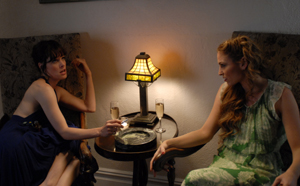
After that screening, I had just enough time to grab another slice of pizza from Used To Be a Burrito Place before I had to dash across the shopping center to the Yarrow for my fourth and final film of the day, a cute-enough relationship comedy called “Broken English.” Parker Posey plays a New Yorker who is unlucky in love; hilarity ensues.
It was only 9-ish now, and awfully early to be going back to the condo, especially on the first Saturday of Sundance, when surely there would be frivolity and merriment up on Main Street, but dang it, there were deadlines to be met. Moreover, it was about 2 degrees outside, and the wind chill factor made it feel even more arctic, so I headed home. Where’s global warming when you need it?!
Day 4 (Sunday, January 21):
AOL has a presence at this year’s Sundance Film Festival, which is probably surprising to you because you didn’t realize AOL was still in business. But still in business AOL is! (Apparently.) AOL owns MovieFone, which is apparently also still in business, and together they have sponsored the AOL Cyberlodge on Main Street.
We know about the AOL Cyberlodge because AOL put notepads and pens with the AOL logo in everyone’s mailboxes at the press office. I went to the cyberlodge first thing this morning, figuring that since its whole purpose is to provide people with a place to use the Internet, surely they would have an electrical outlet into which I could plug my ancient laptop.
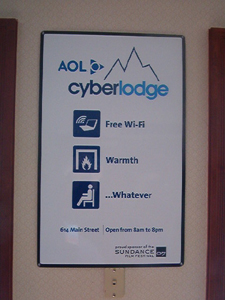
Sometimes I wonder how I manage to remain so optimistic despite enduring one failure after another. Surely I should be the subject of one of those inspirational billboards.
The AOL Cyberlodge is decorated with modern furniture and flat-screen TVs (showing MovieFone film-pimping features), and adorned with 19 laptops, free to be used by anyone. Within moments, I located four unused electrical outlets! But do not be excited, dear reader, and please disregard the premature exclamation point. For all of these electrical outlets had been covered up with electrician’s tape, to prevent anyone from using them.
I asked the sultry blonde managing the place if there was an outlet I could use. She said there was not, but that the coffee shop two doors down had outlets, and I’d be able to access AOL’s free wifi server there. I said, as if seeing them for the first time, “Oh, I see you’ve even covered up these empty outlets.” She said yes, that was a necessary precaution, because if people plugged into them, it would overload the system.
I admit that my knowledge of electricity is rudimentary at best, but I find it hard to believe that the AOL Cyberlodge has EXACTLY enough power to handle the 19 laptops, and that if even one more laptop were to be plugged in, it would blow a fuse and plunge all of Main Street into darkness. But I am not one to argue with sultry blondes, especially nice ones who offer viable alternatives, so I thanked her and walked to the adjacent cafe.
The cafe was your basic coffee shop, with tasty pastries and hot beverages and several electrical outlets near the tables. The fact that the AOL Cyberlodge’s wifi server does not, in fact, actually reach to the cafe seemed irrelevant, what with the delectable hot chocolate I drank there.
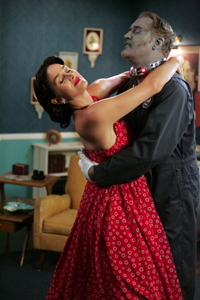
I headed down to the Yarrow/Holiday Village area next, for an 11:30 a.m. press screening of “Fido.” This is another movie with a great-sounding premise: It’s the 1950s, and the nation has been overrun by zombies, but scientists have devised a restraint collar that, when placed on a zombie’s neck, renders him docile and harmless. People keep them in their homes as domestic help, and the film’s protagonist, a little boy named Timmy, finds that his zombie is soon a friend, a playmate, a protector, and a confidante.
While it has some solid laughs and a fantastic production design (cheery ’50s colors abound), it’s ultimately not a great movie. Its fun premise wears thin halfway through. Turns out zombies-as-pets isn’t quite enough to sustain a whole film. Who’d have thought?
Very shortly after “Fido” was another film with an intriguing premise. It’s called “Zoo,” and it’s a documentary about the Washington man who died in 2005 as the result of injuries suffered while having intimate relations with a horse. Predictably, the screening room was packed. Who doesn’t like to watch the anatomy of a trainwreck?
Alternate titles for the film were flying fast and furious among the assembled members of the press. The best one I heard was “Horseback Mountain” (or perhaps “Mountin'”), though I liked what The Oregonian’s Shawn Levy said, too: “… And the Horse You Rode in On.”
Once again, however, we were let down. The filmmakers treated the subject with a disappointing amount of seriousness. What’s more, they turned it into an ethereal, experimental sort of doc, with reenactments, voice overs from some of the man’s friends, and a strange interview with the police officer hired to play a police officer in the reenactment. Double-you tee eff? All in all, it was a snoozer — not nearly as interesting as you expect a movie to be when it’s about a man being horsed to death.
Afterward, Weinberg, Kim Voynar, and I ate at Burger King (well, Weinberg and I ate; Kim eschews fast food), discussing the film as we did so. (If you are wondering whether the topic makes for appetizing lunch conversation, the answer is no.) We talked about the things the movie SHOULD have addressed: What constitutes “animal abuse”? Was the horse actually harmed? What’s up with the people — “zoophiles” — who have what they consider to be romantic relationships with animals, and where on the Internet can we find video footage of them?
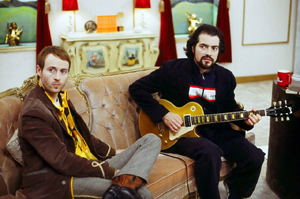
Next up was “On the Road with Judas,” which just might beat out Crispin Glover’s ludicrous “It Is Fine! Everything Is Fine.” for worst film of the festival (so far, anyway; it’s only Sunday). It’s about a guy who writes a novel about a young man and a young woman’s relationship. In his mind, these characters really exist. Then the book is made into a movie, so actors are hired to play the characters. Then a talk show interviews the “real” people (who only exist in the writer’s head, mind you), as well as the actors playing them, and we see the whole story, sometimes with the actors doing the scenes, sometimes with the “real” people doing them.
The whole thing’s an insufferable wankfest, the kind of crap where the filmmaker thinks he’s being all clever and postmodern by actually mentioning the fact that nothing happens in his story. But guess what, Hector: Acknowledging the fact that you suck as a storyteller doesn’t excuse the fact that you suck as a storyteller.
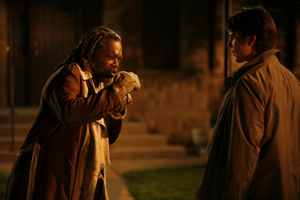
My fourth film of the day proved to be the best: “Resurrecting the Champ,” in which a sports journalist played by Josh Hartnett finds a former professional boxer, played by Samuel L. Jackson, living on the streets. The film is more about journalism than you’d expect, and more about fathers and sons than you’d think, too, and Hartnett is surprisingly good in the role. He still has that unibrow, though, which you’d think some makeup technician would have dealt with by now.
Having thus far spent three full days at Sundance without going to a party, event, shindig, soiree, or even a to-do, I really wanted to attend the affair being sponsored by Film.com. The slave-drivers at Salt Lake City Weekly insisted I file reviews and reports, however, but I figured I could fart that stuff out pretty quick and then get to partyin’. Writing was easy enough once I found an electrical outlet (in the middle of the Yarrow Hotel lobby, on the floor), and filing the reports was OK once I located some wifi (in the lobby outside the closed-for-the-day Sundance press office).
Film.com is a great domain name, of course, and it was a decent Web site until 2001, when it went defunct. Now it is being relaunched, and the party was in celebration of that fact. The guy who invited me, curiously enough, was on the junket with me that resulted in my “I Was a Junket Whore” article last August. He is not a junket whore (it was only his second one ever), which is how we are able to be pals now.
The party was at the Star Bar, Sundance’s official music venue, located way the hell up at the very top of Main Street. You get off the shuttle bus, and then you walk straight uphill for several blocks in the 10-degree cold, taking a sherpa with you if necessary, though often even the sherpas will say, “I cannot go any farther, sir! I urge you to return to the base camp!” The frozen bodies of previous explorers litter the sidewalks.
I trekked up the hill, however, and into the party, which was in full swing. A series of indie bands were performing — first West Indian something, and then Apples of something something — and many young hipsters were milling around, enjoying the open bar and the dim lighting. The classiest part of the evening for me was when I finished my Coke beverage and, believing the drinking vessel to be a disposable plastic cup, dropped it into a garbage can, only to realize after I’d let go of it that it was a regular glass-glass. It shattered when it hit the bottom of the can. Whoops. Put it on Film.com’s tab, I guess.
I ran into a few Utah friends, along with the non-whore who had invited me, chatted for a while, and then headed back to the condo. It turns out I like the idea of partying more than actual partying, but I guess that’s true of a lot of things.
Day 5 (Monday, January 22):
I had been assigned to cover an 8:30 a.m. screening today, but City Weekly honcho Scott Renshaw generously swapped my schedule with someone else’s, knowing as he does my tendency to not always wake up in time for 8:30 a.m. screenings. Part of me was offended, but most of me was glad.
So after sleeping in a bit (9 a.m.), I went to press headquarters to check on some stuff and do a little writing. Ran into Weinberg there, and we headed over to the Yarrow together. As we were exiting the Park City Marriott (home of Sundance headquarters during the festival), we saw Ryan Reynolds coming in. He is taller and not as pretty as he looks in movies.
Weinberg and I then had this conversation:
ME: What’s he doing here? Is he in a movie?
WEINBERG: He’s in “The Nines.”
ME: Ah.
WEINBERG: What, he couldn’t just be here? Maybe he’s just a lover of good films!
ME: You’d think he’d be in better ones, then.
My first press screening of the day was “Expired,” in the festival’s “Spectrum” category. Everything is divided into categories here. There’s Premieres, which is for films that already have distributors lined up, or that are in some other way not entirely “independent” movies. That’s often where the big-name celebrities appear. Then there are the competition categories: U.S. Dramatic (meaning fictional, not necessarily “dramatic”) and U.S. Documentary, with corresponding categories for foreign films, too. Park City at Midnight is the category for films that are frivolous, loud, gory and/or otherwise aimed at a “midnight” type of audience. And then Spectrum is for movies that don’t really fit anywhere else.
The trouble is, Spectrum usually winds up being movies that aren’t quite good enough to be in competition but that have recognizable celebrities in them, so they get included. That, or someone at Sundance owes someone a favor, or the filmmaker has had stuff here before. (Honestly, if I had made that Crispin Glover movie, Sundance wouldn’t have even bothered to send me a rejection letter. But since it’s Glover, whose last film played here two years ago, it’s grandfathered in.)
“Expired” certainly fits the mold of sub-par Spectrum movies. Samantha Morton and Jason Patric star as L.A. meter maids, she a quiet, mousy woman, he an insecure, arrogant jerk who treats her poorly. You know there are two possible outcomes: Either she will summon the fortitude to stop putting up with his crap and tell him to get out, or she will soften him and he will become a better person. Then it’s two hours of waiting for one of those to happen, enduring his insults and ludicrous behavior in the meantime.
The problem is, he’s not a jerk in a realistic way. He’s a jerk in a movie sort of way, where the things he says are designed to get laughs from the audience, not to represent his character. It rings false.
Sitting in front of me during the film was yet another a-hole with a BlackBerry habit. He got it out and used it at least a dozen times. I had decided I was going to start writing down the names of people who do this — everyone wears their press or industry badge on a lanyard — and post them here, but he left before the movie was over. (Typical industry a-hole behavior: diddle on your BlackBerry the whole time, then leave early. Why’d you show up at all, schmucko?)
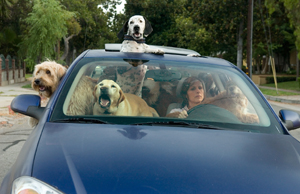
Next up was “Year of the Dog,” written and directed by Mike White, who wrote previous Sundance entries “Chuck & Buck” and “The Good Girl.” This one’s about a California woman who loves dogs and who starts to become a Crazy Dog Lady as her passion for animal rights grows. She is played by Molly Shannon, which probably explains the presence of several people from Advocate magazine sitting behind me: The gays love Molly Shannon. Not a bad film, overall.
There were two BlackBerry offenders during this screening, one over my right shoulder and down a few seats (so I could see it in my peripheral vision every time it lit up), and one just in front of me. The guy behind me, a youngish fellow of South American or perhaps Mediterranean descent, left before I could see his nametag. The one in front of me, a thin, dark-haired woman, exited with me … but her badge had flipped around so I could only see the back of it. Curses! My plan to expose BlackBerry abusers was being foiled at every turn!
I had lunch with a couple people at Used To Be a Burrito Place, and then went up to Main Street for some wandering around and writing. I wanted to give the Sundance House — noted in a previous entry for having a lack of places to plug things in — another try. Maybe it would be less busy today, as a lot of people leave the festival after the opening weekend.
Things were much slower, to be sure: The Internet lounge was closed for a private function of some kind. I didn’t need their laptops, but I did need a place to sit down and use some wifi. What’s the point, dear Sundance friends, of telling us how cool the Sundance House is, and how we should totally stop by and chill whenever we feel like it, if it’s going to be randomly closed sometimes?
I asked a young woman at the front desk if there had been a notice at the press office that I’d missed, though I suspected the answer was that there had been no notice, and that we were supposed to know about the closure via ESP. The young woman actually works for the Kimball Art Center (which is what the Sundance House is the other 50 weeks of the year), so she wasn’t sure what Sundance’s deal was. I told her I just needed a place to sit down and use some wifi. She saw my press badge and said, “You work for City Weekly?” I told her I did. She smiled in an “I’m cool; I’ll do you a favor” kind of way and led me to the back office, where she set me up with a desk and a chair and a phone line and everything! I don’t know what City Weekly ever did to curry the Kimball Art Center’s favor, but I’m glad they did.
The helpful girl’s name is Annie Kennedy, and she is an artist her own self. I bet if you went to www.AnnieKennedy.net [dead link], you would find some representations of some of her work.
I still had time before my next screening, so I headed back down the hill and parked myself at a Starbucks for a while, enjoying some hot chocolate and a piece of crumb cake while I wrote, read, and relaxed. I can’t think of anything funny to say about that, so maybe I’ll just omit this paragraph.
Back at the Yarrow at 7:30 was “Padre Nuestro,” an American-made but Spanish-language drama about two teenage boys from Mexico, one honest and one dishonest, who go to New York. One is looking for his father; the other is looking for easy money. There was lying, deception, manipulation, fraud, and prostitution — and that was just in the lobby before the film started! (That joke is so stupid I’ll probably cut it out before I post this.) Great performances, but the film is too bleak for its own good.
Afterward, Weinberg and some of his Internet movie buddies were congregating in the Yarrow’s bar-and-grill. It’s normally called Charlie’s Place, but during the festival it’s Rocket 88 Burning Man Bar, whatever that means. It sounds like what happens when Japanese products are translated into English, though there is no Japanese influence detectable in the decor or menu.
Anyway, I joined Weinberg and the gang — folks from Rotten Tomatoes and Film Threat — for some junk food, and was about to call it a night when Weinberg mentioned he was going to a midnight public screening of a horror flick called “The Signal,” and did I want to go?
In previous years, there might be as many as six or seven horror films among Sundance’s 120-ish offerings. Gems like “The Blair Witch Project,” “28 Days Later,” and the first “Saw” premiered here. But this year, “The Signal” is the only true out-and-out horror flick on the docket, at least as far as we’re able to determine by reading the film guide. There’s a press screening later in the week, but it conflicts with something else I want to see — and besides, a midnight public screening is almost always going to be more fun than a midday press-only affair, if only for the absence of BlackBerrying a-holes.
So Weinberg and I set out for Main Street. We waited for the shuttle bus for a few minutes, but time was of the essence, and the shuttles are only dependable up to a point, so we opted for a cab instead. There were a bunch of other young movie-goers at the shuttle stop, too, so we asked if any of them wanted to split the cab with us. Four did. The six of us crammed in, split the cost, and paid about a dollar apiece. From an economic standpoint, it was a brilliant maneuver.
The screening was at the Egyptian Theatre, a charming old playhouse near the top of Main Street that can serve as a movie theater when called upon to do so. Weinberg and I got seats up front (there’s a good distance between the screen and the front row) with a couple of Weinberg’s buddies from Ain’t It Cool News, and I went to the bathroom.
In the bathroom, whom should I run into but Hubbel Palmer, an old acquaintance from my Brigham Young University days who appeared in “The Sasquatch Dumpling Gang” (an audience favorite at last year’s Slamdance festival) and who this year has written and starred in a Slamdance comedy called “American Fork.” I’d heard about the existence of this film and was curious to see it. American Fork is a small city in Utah, near Provo, and having lived in that area for several years, I am well aware of the heights of comedy that can come from examining such a place.
Hubbel invited me to a screening of “American Fork” on Wednesday. He was at “The Signal” with “American Fork” (and “Napoleon Dynamite”) producer Jeremy Coon and “American Fork” director Chris Bowman. These guys were all in BYU’s film department around the same time, along with “Napoleon Dynamite” director Jared Hess and star Jon Heder, and I sort of knew some of them back in those days. I was at least familiar with a lot of the short films they made; Bowman’s “The Wrong Brother,” about Orville and Wilbur Wright’s less famous younger brother, is still one of my favorite shorts ever. (I looked for it on YouTube, but it’s not there. You’ll have to take my word for it, I guess.)
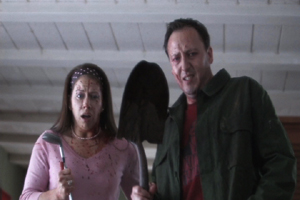
But back to the matter at hand: “The Signal.” It’s about a city where suddenly all the TVs, radios, and phones start producing a strange signal that causes people to lose their minds and become murderous. That sounds a bit like Stephen King’s novel “The Cell,” but to be fair, when you write 100,000 novels, people are bound to duplicate some of your ideas at some point. It’s just the law of averages.
“The Signal” is great. It’s divided into three chapters, all following the same story but from different points of view. The first chapter is tense and frightening, the second has a lot of great comedy, and the third wraps things up, but all three are thrilling and terrifying and fun. It’s definitely R-rated (so what were all those BYU alumni doing there?!?!?!!?!?!?!?!??!?!), but if it were marketed correctly, it could easily make millions from the horror fans.
I would like to have stayed for the Q&A afterward, but I was parked in an area that says no parking after 2 a.m., and it was now 1:50. Having been towed in Park City before, I wasn’t eager to repeat the experience, so Weinberg and I dashed out to the shuttle, which luckily was running quickly and smoothly at that time of night, and made it back to where I was parked at 2:05. Success! Except now I’m a little afraid to turn on the TV.
Day 6 (Tuesday, January 23):
I felt justified in sleeping in this morning, since I’d been out until after 2 a.m. Plus, yesterday was the last day of City Weekly’s coverage, so I had no more specific assignments for that organization. Plus, I don’t have to explain myself to you, so get off my back.
I was actually awakened at 9:30 by the gentle, soothing hand of City Weekly overlord Scott Renshaw, who told me I needed to move my car because I was blocking another CW correspondent who had to leave. I completed that task and then heard refreshing news from Renshaw: The Oscar nominations had come in (that part wasn’t news; I was expecting them), and “Dreamgirls” had NOT been nominated for Best Picture!
The reason this is refreshing is that certain pundits and observers have been declaring this film a front-runner, even a shoo-in, for MONTHS, even before they saw it. And while it’s a perfectly good movie, it’s not the Best Picture of 2006. Seeing it not even get nominated meant we could breathe a sigh of relief, for if it had gotten a nod, there would have been the chance it would actually win. Now the only one we have to worry about winning is the mediocre “Babel” — which, considering its similarities both in content and quality to “Crash,” might pull it off, since apparently the Academy loves crappy, obvious “message” films about ridiculous coincidences and plot contrivances.
But none of this has to do with Sundance, so I will get back to the point.
None of the morning press screenings appealed to me, so I went to press headquarters to check on some public screenings. They’ve changed this process this year, and not for the better. It used to be that at the Eccles and Library venues (the two largest), members of the press could show up an hour before a public screening and they’d have some tickets to give out, about 50 at the Eccles, and 10 at the Library. For other venues, you had to request a ticket 24 hours in advance, but it usually wasn’t a problem.
As of this year, ALL tickets for public screenings must be requested a day in advance. The general impression we’re getting is that they want the press to stay at press screenings only, and leave the public screenings for the public.
At any rate, I requested a ticket for tomorrow’s public screening of “Joshua,” which I’ve heard great things about. The personnel handling ticket requests said immediately that all the available press tickets had already been given out for that showing, “before we even opened this morning.”
I said, “Can I request a ticket to the other public screening, then, two days from now?”
“No, you can only request tickets the day before.”
I knew this, but I had asked so that I could make my next point: “Then how could all of tomorrow’s ‘Joshua’ tickets have been given out before you even opened today, if today was the earliest anyone could have requested them?” You can see that I have learned cross-examination from the master, Assistant District Attorney Jack McCoy on “Law & Order.”
The answer to my question required calling over another ticket person, who explained that perhaps it hadn’t been meant LITERALLY, but that as soon as they opened today, the few tickets set aside for tomorrow’s “Joshua” were snatched up. The point is, there had only been a few tickets to begin with — not the 50 there would have been in years past — and they were gone within minutes of the press office opening this morning.
(I should also point out that the Sundance press office personnel are unfailingly polite, informed, friendly, and tireless. I was frustrated, but I don’t think I was short with them. At least I hope I wasn’t. Don’t get on the bad side of people who control your access to tickets, that’s my policy.)
I had a couple options for this afternoon. There was a press screening of something called “Son of Rambow” at 1:30, but there was also a public screening of “The Ten,” written and directed by David Wain (whom I saw earlier in the week, you’ll recall) at 2. I’d been interested in seeing “The Ten” anyway, and my curiosity grew when I overheard a woman say it was among the worst films she’d ever seen. Whenever I hear such superlative statements about a comedy — especially one I think is likely to be good — I think, “Well, maybe you just didn’t get it.” (Please note: This does not apply to movies by the Wayans Brothers. Those actually ARE terrible.)
Since “Son of Rambow” and “The Ten” were playing at adjacent venues, I figured I could see what the wait-list situation looked like for “The Ten,” and if it didn’t look promising, I’d have “Son of Rambow” to fall back on.
My question was soon answered: Outside of where “The Ten” would be playing, a sign had been posted saying there was NO HOPE for wait-list tickets, so don’t even bother getting in line. So much for that.
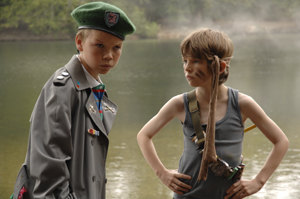
As it happens, I’m glad I couldn’t get into “The Ten.” A press screening will probably be scheduled for one of the still to-be-announced slots later in the week, and “Son of Rambow” turned out to be my favorite film of the festival so far. It’s a hilarious, imaginative, and touching comedy about two young boys in England in the mid-1980s. One is a troublemaker and rabble-rouser, while the other is from a strict family that won’t let him watch TV or go to the movies. The two lads bond when they are exposed to “First Blood” (aka “Rambo I”), and their fondness for it drives them to make their own version using their home videocamera. The film perfectly captures the whimsy of little boys’ imaginations, as well as the tenuous friendships kids have. I laughed more during the movie than I have all week — pure, childlike laughter, not the dirty kind of laughter I had during the movie about the killer hoo-hah.
Before the screening began, the theater staff made a special announcement to the effect of “Don’t use your BlackBerrys during the movie; the light is really bright, and it annoys everyone around you.” (It is possible they made this announcement specifically because I asked them to.)
Of course, if you’re self-absorbed enough to use your BlackBerry during a movie, then you’re probably also self-absorbed enough to think that you’re the exception to the announcement telling people not to. And sure enough, right in front of me: a-hole BlackBerry user, female, slender, laughing and enjoying the film when she was paying attention to it, but otherwise heavily engaged in communicating with the outside world.
I started leaning way over so I could see what she was writing, and she didn’t seem to notice. One of her messages read: “Can you call HD Net to get me Jason’s cell number?”
When I read that, I started to feel bad. I’d been judgmental, assuming that anyone using a BlackBerry during a movie was ill-mannered and self-important, and that their correspondence was frivolous. It never occurred to me that someone might need Jason’s cell number! Jason was probably frantic with worry, wondering why this woman hadn’t called him, not realizing she didn’t have his number. And the people at HD Net were going through their day tragically unaware that they were in possession of a valuable piece of information. If only someone could be told to call HD Net to get Jason’s number! All this senseless chaos could be eliminated.
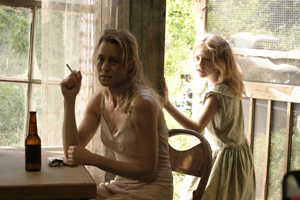
After “Son of Rambow” was another hotly debated, highly anticipated press screening: “Hounddog,” aka “The Movie Where Dakota Fanning Gets Raped.” I first heard about this movie last August, when production began, and it’s recently been the topic of discussion all over the media. Everyone wants to know: Is it exploitative? Even if the rape scene is discreet, does the very IDEA of it exploit the 12-year-old Dakota Fanning? And how discreet is it? Do we see any of South Dakota? (I am deeply, deeply sorry for that joke.)
Members of the press were lined up an hour early, and some wound up being turned away because the venue was filled to capacity. The other press screening this packed was “Zoo,” a few days ago. Basically, if your movie includes sex with a horse or sex with Dakota Fanning, WE ARE ALL OVER THAT.
They let us into the screening room quite early, and as is my custom, I went to the bathroom a few minutes before the movie started. You have to sign in at the press screenings (so the publicists will know who saw the film), and if you leave they stamp your hand so that you don’t have to sign in again when you return. You can stack up a few ink stains over the course of a day, and as I was exiting, a fellow journalist remarked on that by saying, “You end up looking like Queequeg in ‘Moby Dick.'” I laughed heartily, despite not getting the joke.
The verdict on “Hounddog”: “Hounddog” is a hound dog. Fanning’s performance as a backwoods Southern girl with a creepy, worthless father and a religious-zealot grandmother is fantastic, but everything else about the movie is wrong. It’s loaded with symbolism so obvious it might as well be subtitled (“THIS SNAKE REPRESENTS EVIL!!”), and it has what Spike Lee calls a “magical negro” character, i.e., the wise old black man whose every line of dialogue is instructional in some way and who has vaguely mystical powers. Bleh.
The rape scene is brief — under 30 seconds — and is discreet indeed. What’s not discreet is the way Fanning is sexualized throughout the film, frequently cavorting in the swimmin’ hole in wet clothes, or being bathed and de-loused by her grandmother, or gyrating while she sings Elvis Presley’s “Hound Dog” for the amusement and titillation of grown-ups. Does Fanning not have parents? Oh, right, she has a mother who is also her manager, and who has said she thinks this will be a good chance for her daughter to win an Oscar. Be sure to get your Mother of the Year nominations in early!
Following the “Hounddog” debacle (and this was one where we critics seemed united in disliking it), Cinematical’s Kim and I ate dinner at the Yarrow Hotel’s cafe. Predictably, the conversation was lively and the service was lousy.
I wrote for a couple hours after that before joining Weinberg and Childress for a 10:30 p.m. press screening of “Chapter 27,” in which a fattened-up Jared Leto plays John Lennon assassin Mark David Chapman in the three days leading up to the murder. He speaks in a high-pitched Southern drawl that sounds like a cross between the creepy old-man pedophile on “Family Guy,” and Winnie-the-Pooh.
Basically, it boils down to this: John Lennon gets shot to death in “Chapter 27.” If you try to sit through the movie, you’ll envy him. It’s one of the most utterly plot-free films I’ve ever seen. Chapman shows up in New York, hangs around for a couple days, then kills Lennon. That’s it. I have told you the entirety of the story, and yet I have spoiled nothing. There’s no insight, no analysis, nothing. Just Jared Leto talking to himself for 90 minutes. Folks, if I wanted that, I would invite Jared Leto over to my house and listen to him there.
There’s a scene about 45 loooong minutes into it where Chapman is talking about movies with a fellow Beatles fan he’s met, played by Lindsay Lohan. She says she didn’t like “Rosemary’s Baby” because “it’s slow-moving, and nothing happens till the end.” At that the screening audience snorted with derisive laughter.
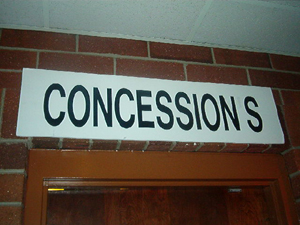
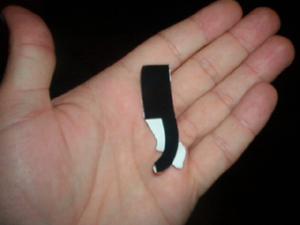
It was about midnight when it ended — though it felt like midnight several days later — and Weinberg, Childress, and I walked over to the Yarrow to see if anyone was hanging around there. It was pretty dead, even at Rocket 88 Lucky Bar Good-Time Table Place. I took this opportunity to go out in the hall, stand on a chair, and remove the offending punctuation from the “CONCESSION’S” sign, another trophy for my collection. I did it quickly, easily, and without talking to myself in an effeminate Georgia accent for three days beforehand. I’m more efficient than Mark David Chapman, is my point. I definitely would have taken out Yoko, too.
Day 7 (Wednesday, January 24):
With City Weekly’s festival coverage finished, we were no longer justified in staying in our cozy condo, and this morning was check-out time. So sad. We’ve stayed there two years in a row now, and I’ve still never used the hot tub.
Went to press headquarters to write for a bit, then walked over to the Holiday Village Cinemas for my first screening, “Fay Grim.” It’s from veteran indie filmmaker Hal Hartley, who is loved by many but whose only film I’ve seen is “The Girl from Monday,” and it was one of the worst entries in the 2005 Sundance Film Festival. So while I was entirely in favor of giving Hartley another chance — we all have our “off” days, after all — I was wary of “Fay Grim.”
It’s a sequel to a previous film, “Henry Fool,” but seeing it doesn’t seem to be a prerequisite to understanding the new one. (I guess when 99.9 percent of the American public has never heard of you or your movies, you can’t really get away with making sequels that demand familiarity with their predecessors.) It stars Parker Posey as Fay Grim, a New York woman who is enlisted by the CIA to retrieve some of her dead husband’s notebooks, as they are believed to contain state secrets. It’s a comedy to begin with, then it gets kind of bogged down in its espionage stuff, but it’s fairly entertaining overall. I’ll have to see another Hartley film sometime and do a best-two-out-of-three sort of thing.
Sitting behind me at “Fay Grim” was none other than Leonard Maltin, who I don’t recall ever seeing at Sundance before. He and a couple other critics were chatting about what they’d seen, and one of the fun things about Sundance is that it’s not considered rude to join a conversation if you have something relevant to add. (Well, a movie-related conversation, anyway. I guess if people were talking about their colonoscopies, it would be rude to butt in and talk about yours, just as it would be anywhere else.)
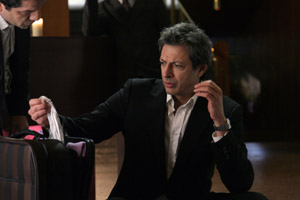
After a few minutes, the others left, and Maltin formally introduced himself. I told him I was familiar with his work, and we chatted about movie reviewing and so forth. Somehow we got to the topic of quote whores (the lousy critics who will claim to like anything as long as it gets them quoted in the ads), and he made some amusing comments about that practice, and how TV commercials will say “The critics are raving!” when in fact they only have quotes from one critic. Maltin is plenty famous and plenty rich, but I was impressed by how friendly and chatty he was. Nice guy.
I had a bit of Burger King for lunch before heading up to the top of Main Street, where I was to see a Slamdance film at 3:30. Slamdance, if you’re not familiar, was launched several years ago as an alternative to Sundance. Sundance used to be cool, man, then it got all bogus and corporate. Slamdance is what Sundance USED to be, dude, before it sold out. Or so they say. Whatever.
Thus far, the only film to be launched at Slamdance that has gone on to significant notoriety is “Mad Hot Ballroom” — and even then, the national media were so surprised that many reports mistakenly said it had debuted at Sundance. Doh! Poor Slamdance. It’s like Sundance’s stoned little brother, tryin’ to make it in this big, crazy world, but never being taken seriously.
As I mentioned in a previous report, I’d been invited to a screening of “American Fork,” made by some of my fellow BYU alumni and playing as part of the Slamdance festival. I knew some of the people involved to be very talented, and there wasn’t anything happening at Sundance this afternoon that needed to take priority, so I went a-Slamdancin’.
The small, uncomfortable screening room was packed with friends, family, and regular Slamdance-goers, and many of the cast and crew were on hand for questions afterward. The film, about an overweight loser living in a medium-sized Utah town (American Fork, presumably, though the name is never mentioned), has a lot of good laughs and some nice dramatic turns, too. Much of the humor is character-based, similar to “Napoleon Dynamite” (also made by BYU alumni, and sharing a producer, Jeremy Coon, with this film), and the plot is similarly thin and meandering. “American Fork” is a thematically richer movie, though, with characters actually learning and changing. It’s not brilliant work, but it’s good. It deserves to be seen.
My problem all week, as you know, has been finding an electrical outlet and some wifi. I can usually find one or the other, but not both. Imagine my Christmas-like surprise, then, when I wandered into the galleria on Main Street after seeing “American Fork” and found 1) a place to sit down, 2) an electrical outlet, and 3) wifi! I nearly wept with joy.
There’s a movie playing at Sundance called “Chasing Ghosts,” a documentary about the Pac-Man craze of the early 1980s. To promote it, they’ve rented out a space in the galleria and filled it with arcade games that you can play for free. I didn’t have time to indulge, but I was amused to see someone come out of the place dressed in a Pac-Man costume. He was walking around the mall, cheerfully saying to people, “Hey guys! I’m Pac-Man!” I thought: When you’re dressed in a big yellow Pac-Man costume, do you really need to tell people who you are? Seems like if they don’t immediately recognize you, telling them your name isn’t going to help.
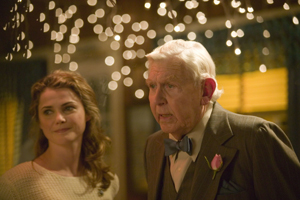
I headed back down the mountain next for a press screening of “Waitress” at the Holiday Village Cinemas. The film was written and directed by Adrienne Shelly, an actress whose name you might recognize because she was murdered on Nov. 1, 2006. (The story was noteworthy because the guy who killed her had arranged the body to make it look like a suicide, initially fooling investigators.) It’s already been picked up by a distributor, but some of us wondered whether that was because it’s good, or because of the backstory. (“See the film she was working on when she died!”)
I loved it. Weinberg, Childress, and several of our other Sundance buddies were in attendance, and we all absolutely loved this movie. It’s a comedy about a Southern small-town diner waitress (played by Keri Russell) who’s stuck in a loveless marriage to a possessive jerk. Her plan to leave him is complicated when she gets pregnant. Further complications arise when she starts having an affair with her doctor (Nathan Fillion, from “Firefly” and “Serenity”).
So, um, yeah, it doesn’t sound funny. But it is! Trust me! Nathan Fillion and Keri Russell are both wonderfully funny and charming, and guess who turns up in a pivotal supporting role as the owner of the diner? Andy Griffith, ladies and gentlemen.
Griffith has very seldom appeared in theatrical films over the course of his career, and nothing since his bit part in 1996’s “Spy Hard.” Why he chose to do this little independent movie, of all things, I have no idea. But thank goodness he did! His character is an ornery, demanding old man, but thoroughly lovable and good-hearted.
The film is about finding happiness. It doesn’t judge its characters for their somewhat questionable behavior (there’s more than one adulterous affair in the story), but it doesn’t condone them, either. It just lets them be who they are — flawed, beautiful, and funny. It’s one of the sweetest, most delightful films I’ve seen in a long time.
Day 8 (Thursday, January 25):
I slept on the floor of Childress and Weinberg’s hotel room last night, until 7 a.m., when Childress left for the airport and I took over his bed. Weinberg had to leave a few hours later, and I went about my day.
Actually, before he left, Weinberg and I and several other press people sat around at press headquarters talking about the movies and what the pluses and minuses of the festival had been. It was a jovial, pleasant conversation, with people agreeing and disagreeing good-naturedly, the way professionals do. And then Robert Koehler from Variety showed up and started arguing with everyone, bluntly and tactlessly.
It’s one thing to disagree, of course. We’re critics; we often have strong opinions, and those opinions often differ from our colleagues’. But Koehler was abrasive about it. Perhaps he is defensive about the fact that, since Variety’s main purpose is to report on the business of movies and not on their artistic merit, no one cares what a Variety critic thinks.
After he was gone, I got into a conversation with a fellow writer about the BlackBerry a-holes (or BerryHoles, as my mom has taken to calling them). His position was that it’s OK to BlackBerry during a movie at Sundance! His reasoning was that these are press-and-industry screenings, which means they’re for work, not play, and that sometimes work must be done. People who represent studios that might want to buy these films may need to conduct business while the film is being screened.
I countered that if these screenings are business functions, why not go ahead and make phone calls during them, too? He said the BlackBerry is a concession, a way to find middle ground between making phone calls and doing nothing at all.
He has a point about the screenings being for work and not recreation, but I still see no reason why, if business must be conducted, a person couldn’t go out into the hall to conduct it. He said he never notices the light from BlackBerrys because he’s concentrating on the screen — and furthermore, if one does get distracted, it’s one’s own fault for allowing it to distract one.
It will not surprise you to learn that this individual is himself a BlackBerry user. He prefers it to pen and paper when it comes to note-taking. He said he always sits in the back corner of the theater, though, to avoid bothering anyone … which is very generous of him, considering it would be the person’s own fault if he or she were bothered.
Anyway, he seemed like a nice guy, and I lent him my pen so he could do the crossword puzzle in the newspaper. We disagree on the BerryHole issue, but we had common ground in other areas, e.g., that Bob Koehler is obnoxious.
My first screening of the day, which I saw with my new Rotten Tomatoes and Film Threat pals, was “King of California,” in which Michael Douglas plays a crazy guy who becomes convinced there is Spanish treasure buried beneath a Costco. Evan Rachel Wood plays his daughter, marking a rare non-slutty-teenager role for her. The film was not pleasing to us, but not for that reason.
Kim from Cinematical talked me into going to the Chinese buffet after that, even though it’s more expensive than it ought to be and even though the item I like best, sweet and sour chicken, is always in short supply. Nonetheless, when eateries are in short supply, and when time is of the essence, you do what you have to.
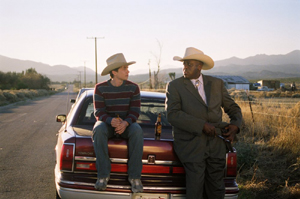
I saw “The Go-Getter” next, starring Lou Taylor Pucci (from “Thumbsucker”) as an Oregon teen who steals a car and goes on a road trip. We sure love Pucci and his co-star, Zooey Deschanel, but we sure got tired of this moody, introspective movie. Too much moping, not enough doin’ stuff — and too typical of an indie Sundance drama.
We were 0-for-2 so far today, but I had high hopes (that’s a pun; you’ll get it in a moment) for the films still on the agenda. Up next was “Smiley Face,” a Midnight section comedy about a pothead girl trying to get through a day while particularly stoned. Anna Faris plays the girl, and as viewers of the “Scary Movie” series can tell you, she’s a genuinely talented comedic actress. If someone would give her a truly great script, she could be a superstar.
“Smiley Face” is funny enough, probably more so if you have personal experience with marijuana and can relate to Faris’ behavior. One very interesting point: Her character is high for the ENTIRE film. It’s hard to sustain the audience’s attention for 90 minutes when the protagonist is in an altered state the whole time, but the movie does an OK job of it.
Everyone was tired today. There was some partying last night that went into the wee hours, and besides, we’ve been at this for a week. You could see people walking around with weak smiles on their faces, languidly shuffling from one screening to another. You could also overhear a lot of cell phone conversations between festival-goers and their travel agents/secretaries/editors, trying to bump up their flight plans. Even when you’re having a good time, all the commotion, not to mention the emotional roller-coaster of seeing four or five movies a day, can take its toll.
I had a break after “Smiley Face,” and I took advantage of something I’d discovered earlier in the week. The Yarrow has wifi available in the lobby if you pay $7 for it — or, alternatively, if you befriend someone who has paid $7 for it and that person tells you the password. Woo-hoo!
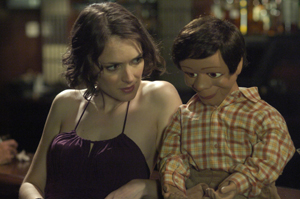
My final film of the night was “The Ten,” another Midnight selection (screening at 10:30, thank goodness). You may recall that earlier, I heard someone say it was one of the worst things she’d ever seen. Turns out my suspicions were correct: She just didn’t get it. Or, more fairly, perhaps it just wasn’t her kind of humor. It’s definitely absurd, surreal, and silly, with things as sophisticated as wordplay and things as lowbrow as flowers growing out of rhino poop.
It’s basically a series of sketches, each one related to one of the Ten Commandments. Some of the characters recur, and there’s a storyteller (Paul Rudd) who introduces each one and who winds up being the subject of the adultery story. The “don’t steal” story has Winona Ryder falling in love with a ventriloquist’s dummy and stealing it. For “don’t covet your neighbor’s stuff,” a suburban husband gets jealous when his neighbor buys a CAT-scan machine, so he buys one for himself. For “keep the sabbath holy,” a guy doesn’t feel like going to church, so he fakes illness to his wife and runs around the house naked for three hours, eventually inviting all his friends to come over and do the same. And so on. Goofy, goofy stuff.
That was the end of the day for me, and my eyes were a-droopin’ as I drove to Salt Lake, where I crashed at a friend’s house. Or where I slept, that is. No crashing, fortunately.
Day 9 (Friday, January 26):
Aw! It’s like the last day of summer camp! Except that it’s 35 degrees and more people have hangovers. The festival officially ends Sunday, but the awards are announced Saturday, and the press screenings stopped tonight. Many writers, reporters, and critics left yesterday and today, so we’ve all been saying goodbye to each other, promising to write (well, MySpace) and hoping to see each other in Austin in March for South By Southwest.
Most of the press screenings today were of films that had already screened earlier but that warranted another look, either because they’d been the subject of much discussion (e.g., “Zoo”), or because they’d been picked up for millions of dollars and will appear in theaters later this year (e.g., “Son of Rambow”).
Consequently, the friends who were still in town had already seen the films I was seeing today, and I had already seen theirs, so I had to sit by myself at my three screenings. Fortunately, I am a grown-up and a professional, and I go to movies by myself all the time.
First up was “Snow Angels,” whose earlier screening I missed due to oversleeping. It’s a beautifully photographed drama about several characters in a small town. There are many fractured marriages and relationships, and then a community tragedy occurs that tests everyone’s strength. It’s a film I’ll have to think about for a while. I know I liked it, but I haven’t yet been able to analyze what, exactly, I admired.
All three films showing in the next time slot were ones I’d seen, so I had a three-hour break during which to write, doze, and eat lunch. There’s a taco-and-burger place between festival headquarters and the Yarrow, and while I don’t usually trust places that try two ethnicities at once — specialization is where it’s at — I was lured in by the thought of an Oreo shake. It went well with my burger and fries.
Movie No. 2 today was “Joshua,” a psychological thriller about a wealthy New York couple (Vera Farmiga and Sam Rockwell) whose 9-year-old son doesn’t respond well to the arrival of a new baby. Or does he? Part of the fun is not being sure what’s going on. We know something isn’t right, but the source of our unease could be the son, the mother, the father, or someone else entirely. Any film like this runs the risk of being ridiculous, and “Joshua” has its ludicrous moments, but I think it works overall. It’s one of the films that got bought for big bucks, and if it’s marketed correctly, it could do very well when it’s released.
Several writers from Entertainment Weekly sat behind me at the screening. Before it started, they were chatting and laughing, talking shop, and browsing through the new issue. I was overwhelmed with jealousy — first because they still had friends in town when all mine were gone, and second because they work for Entertainment Weekly. It didn’t help that at least one of them was younger than I am. I hate when people younger than myself have better jobs than I do. Although, for all I know, EW could be a terrible place to work, with asbestos in the ceilings and cruel editors. I know the magazine displays an over-fondness for puns in its pages. Maybe it’s a nonstop pun-fest at the office. That would drive me crazy after a while. “Hey, boss, did you read my article?” I would ask, and my editor would reply, “Which article? ‘A,’ ‘an,’ or ‘the’?” And I’d have to chuckle if I wanted to keep my job, even though she’d made the same joke every day for the past year, and even though at this point, I wasn’t even sure I DID want to keep my job. Are the competitive salary and generous stock options and good health coverage worth it for the daily punning I’d be forced to endure? I’m beginning to think not. Man, I hate those bastards at Entertainment Weekly.
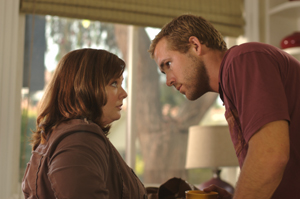
There was just a short break after that film before my third and final screening. It was “The Nines,” written and directed by John August, who wrote “Go” (one of my favorite indie films of the ’90s), “Big Fish,” and “Corpse Bride.” “The Nines” stars Ryan Reynolds as an actor who has a breakdown, rolls his car, and winds up under house arrest. Everything’s very funny at first — John August writes great pop-cultural dialogue — and then weird things start happening. Next thing you know, Ryan Reynolds is playing a character who is entirely separate from, but sort of connected to, the actor.
It’s one of those “What is reality?” movies, with kooky twists and stuff. August seems to be exploring what it means to be an artist, where you can create worlds and people, and then destroy them on a whim. It’s a pretty cool movie, and Reynolds is a better actor than you’d have thought.
That did it for me, Sundance-wise. They’ve scheduled two last-minute press screenings for Saturday morning, but they’re both bound for theatrical release at some point, so I don’t necessarily need to see them now. It will be nice to get a long night of sleep, with visions of horses and Dakota Fanning and Rambo and Andy Griffith dancing in my head. I’ll check in Saturday or Sunday to report on the awards and wrap things up.
Day 10 (Saturday, January 27):
I did nothing Sundance-related today, unless you count going to a matinee of “Blood and Chocolate” — which you shouldn’t, since it’s a stupid movie about werewolves, not a smart movie about blood-thirsty girl-parts.
Sundance used to do a full complement of press screenings on the final Saturday, but they stopped a couple years ago. The awards ceremony was held tonight, and while I didn’t attend, I do have the winners to list, if you’re interested. In fact, I will list them even if you are not.
Jury Prizes (chosen by a panel of filmmakers, writers, and VIPs):
Grand Jury Prize, Documentary: “Manda Bala (Send a Bullet),” a Brazilian film about the violence and corruption in that country.
Grand Jury Prize, Dramatic: “Padre Nuestro,” an American-made (but mostly Spanish-language) drama about two Mexican teens arriving in New York. This award surprises me. I never heard anyone talk about the film, and my own impression of it wasn’t particularly favorable.
World Cinema Jury Prize, Documentary: “Enemies of Happiness,” about Afghanistan’s 2005 parliamentary elections — its first such election in more than 30 years.
World Cinema Jury Prize, Dramatic: “Sweet Mud,” an Israeli film about a boy growing up in a closed community called a kibbutz in the 1970s.
Directing, Documentary: Sean Fine and Andrea Nix Fine for “War Dance,” about the ongoing war in northern Uganda.
Directing, Dramatic: Jeffrey Blitz, for “Rocket Science,” a comedy about a stuttering teenage boy who joins the debate team.
Cinematography, Documentary: Heloisa Passos, “Manda Bala (Send a Bullet).”
Cinematography, Dramatic: Benoit Debie, “Joshua,” the creepy-little-kid thriller.
Waldo Salt Screenwriting Awards: James C. Strouse, “Grace Is Gone.”
Special Jury Prize: “No End in Sight,” a documentary about the Iraq war, “in recognition of the film as timely work that clearly illuminates the misguided policy decisions that have led to the catastrophic quagmire of the U.S. invasion and occupation of Iraq.”
Special Jury Prizes for Acting: Jess Weixler in “Teeth,” the comedy/horror about vagina dentata; and Tamara Podemski in “Four Sheets to the Wind,” set on an Indian reservation in Oklahoma.
Audience Awards (chosen by ballot at the public screenings):
Documentary: “Hear and Now,” in which the filmmaker shows her aged deaf parents deciding, after 65 years of silence, to have cochlear implant surgery.
Dramatic: “Grace Is Gone,” starring John Cusack as a man whose wife is killed in Iraq, forcing him to find a way to tell their young daughters. The film was picked up by The Weinstein Company, and Harvey Weinstein has already said he’s going to push for an Oscar nomination for Cusack. In discussing the film with people who saw it, I gather that Harvey is not being hyperbolic: Cusack is really, really good. Expect the film to be released theatrically this fall.
World Cinema, Documentary: “In the Shadow of the Moon,” about the Apollo Space Program.
World Cinema, Dramatic: “Once,” the charming Irish musical about two street performers. Not surprised here: I liked it a lot, and so did many of the people I heard talking about it.
You may notice I didn’t see a lot of the winners. It’s the luck of the draw. There were 123 new films playing at Sundance this year, and I only saw 28 of them. Plus, the juries only consider films playing in competition, so entries in the Premieres, Spectrum, and Midnight categories — which account for 17 of the movies I saw — aren’t eligible.
Just for fun, I’m going to figure out how many films it’s possible to see at the festival. There are six press screening slots for eight days (Friday through Friday), the first one at 8:30 a.m. and the last at 10 p.m. So that’s 48 movies. Then I suppose you could also catch a public screening at midnight on each of those nights, for a total of 56, and then do another six public screenings on the concluding Saturday (62), and four more on Sunday (66). Of course, that’s assuming the press and public screening schedules work out so that you’re not repeating yourself, and that you’re able to get all the public screening tickets you need, both of which scenarios are unlikely. Plus, you’d be getting no more than five hours of sleep each night, and you’d never have time for real meals, only junk food snacks between screenings.
Anyway, I’m happy with the 28 I saw. I like to aim for about 35, but you can’t overdo it. It’s a marathon, not a sprint.
Day 11 (Sunday, January 28):
I’m just gonna say it: Sundance wasn’t as much fun this year as it used to be. I’m not the only one to make that observation, either. Several of us in the press corps had conversations about it, starting around Day 4. The quality of the movies was typical — some great, some bad, a lot in the middle — so that’s not it. It’s something in the atmosphere, in the overall vibe of Park City. I can’t really put my finger on it.
I can name a few things, though. Changing the public-screening-ticket rules makes us less able to attend public screenings, which is where the directors and stars are often on-hand for Q&A, and where you can share the energy of the audience. Press screenings are more convenient, certainly, but not as much “fun” as public ones.
The press office also used to have screener copies (on VHS or DVD) of some films, which we could borrow for 24 hours at a time and watch at home or in our hotel rooms. As of this year, the screeners can’t leave the building: You have to sit in a little cubicle with headphones on and watch the movie that way. What fun is that?
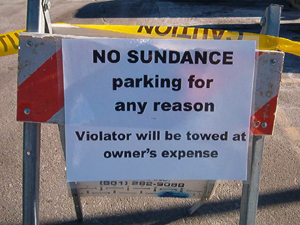
Then there’s the fact that some of the parking lots that used to be free for festival-goers now cost $10 or $15 for the day. It used to be one of my favorite Sundance secrets that you could park at the Yarrow Hotel and no one cared; this year, they’ve started caring, and by “caring” I mean “cordoning off the entrances and charging $15 to park.”
As more and more people come to the festival, the crowding becomes a more urgent problem. Even if you use the shuttle buses instead of driving, you’re still caught in the insane gridlock that takes over Main Street every day during the festival, especially in the 4-7 p.m. hours. The streets are narrow, steep, and clotted. It’s a madhouse.
It all makes the festival feel a little too much like, well, work. And of course it is a job for most of us, and there is work that we’re required to do, and no one’s complaining about that. But in years past, it’s been a lot of fun, too. It was invigorating, exciting work, where you’re exhausted by the end but it’s a good kind of exhausted. This year, I’m just plain tired.
The changes in the festival are attributable to growing pains. The festival gets bigger each year in every way: more press, more industry, more audience members, more movies, more screenings, more venues. Yet Park City remains the same size. The venues that Sundance uses only have so many seats, and there are only so many hours in the day to show movies. The more press and industry people who attend, the greater the likelihood that someone will make copies of the screeners (surely the reason for not letting them out of the building anymore). Festival officials have to do what they can to keep things under control. We all know that the bigger something gets, the less room there is for horsin’ around and havin’ fun.
(I should also point out that the parking lot situation is the doing of Park City and the various owners of the lots, not the Sundance Institute.)
So what will happen? Eventually, if it keeps being too big and not enjoyable enough, fewer press and industry will attend. As it is, there are very few of us who “have” to go. We go because we enjoy it, and because we’re able to convince our employers to pay our expenses or to buy stories from us. If the hassle starts to outweigh the enjoyability, maybe some of us will stop bothering with it.
The same goes for the public — the regular movie-lovers who visit Utah to enjoy the festival, and the locals who like to take in a screening or two when Sundance comes to town. Individual ticket prices went up from $10 to $15 this year, a move Sundance defends as economically necessary but that caused grumbling among patrons and may have kept some people away. Those no-longer-free parking lots are bound to be a factor, too, especially for locals.
Of course, if fewer people go to Sundance, that will reduce the crowds, which will help make it more enjoyable for the people who do go. But is that really what Sundance wants? I doubt it. The idea behind the festival is that it’s movie-making by the people and for the people. Allowing the fest to become such an ordeal that people abandon it doesn’t exactly jibe with the fest’s populist ideals.
All of which demands the question: What should be done? The way I see it, there are three possible courses of action:
1. Extend the duration of the festival. It runs for 11 days currently; expanding to 15 days would let them decrease the number of screenings per day, thus easing the crowds and traffic somewhat. You’d still have press and industry in town for the duration, but at least the crowds of locals would be thinned out.
2. Reduce the number of films and screenings. Nobody wants this. Festivals are supposed to grow, not shrink.
3. Move the festival to someplace that can accommodate the huge crowds. Someplace like, say, Salt Lake City.
I’m voting for No. 3. Salt Lake is just 30 miles from Park City, it’s infinitely more accessible, and it’s already where Sundance’s headquarters are. (The office personnel must pack up their stuff and move to temporary digs at the Park City Marriott every year.) There are numerous ski resorts within an hour of downtown, so the Sundance-goers who have gotten used to hitting the slopes during the fest could still do so.
Salt Lake already has five movie screens — in actual theaters, not hotel conference rooms! — that Sundance uses during the festival, and there are plenty more that could be rented or borrowed. There’s ample parking, the temperatures are usually 10 degrees warmer, there’s not as much ice and snow on the roads, there are more places to eat and sleep — the list of advantages Salt Lake has over Park City goes on and on.
The only thing Park City has going for it is that it’s quaint and picturesque. That was fine when the festival started, and the pristine mountain town of Park City was a good fit for the Robert Redford’s rootsy, idealistic film festival. But the festival has outgrown Park City. A town of 8,000 people simply cannot manage 40,000 visitors for 11 days every year. Moving to Salt Lake might take some of the natural beauty out of the festival, but I guarantee it would make the fest more enjoyable for everyone who attends.
It would also allow for more growth. Salt Lake can easily handle Sundance at its current size, and it could accommodate more films, more screenings, and more venues, too, as the festival continues to expand. Park City is absolutely at the breaking point. The Sundance Film Festival cannot grow any larger and stay in Park City.
Please understand that I make these criticisms and recommendations out of love. I’ve covered the festival full-time every year since 2000, and I have many, many happy memories of the movies, the people, and the overall experience. I’m one of those people who don’t “have” to go, but I do what I can to convince employers to send me. There were a couple years when I went entirely on my own dime because I just couldn’t bear to miss it. It’s a wonderful festival, and I want it to continue to be wonderful.
As always, I am in awe of Patrick Hubley, the world’s most cheerful Canadian, who handles the press-and-publicity side of Sundance with serenity and competence. He took a sabbatical for last year’s festival, and I missed him.
Thanks also to the personnel at the press office, who dole out press kits, tickets, and information smilingly and energetically, despite working long hours and getting little sleep. The volunteers who fly in from around the world to work in the cold and herd festival-goers around are amazing, too. The festival couldn’t function without them. They could maybe use a little more training on which shuttle buses go where, but in fairness, I think sometimes the drivers make up their routes on the fly, without regard for what the printed schedules say.
Finally, a shout-out to Renshaw, Weinberg, and Childress, who are friends as well as colleagues, and whom I look forward to seeing each year. They have each been extraordinarily helpful to me professionally and personally, and I’m grateful for it. I’m also glad to have made some new friends this year, or to have become better acquainted with people I’d met before, from various online outlets — Kim, James, Tim, Jen, Zack, Mark, and Jamie, I hope to see you all again soon. In the meantime, we’ll always have cyberspace.
Some of the best films I’ve seen in my life are films I first saw at Sundance. It’s a vibrant, important festival. I hope the tireless souls who run it can guide it through the growing pains and continue to make it a positive experience for those of us who look forward to it every year. I’ll see you in ’08!


